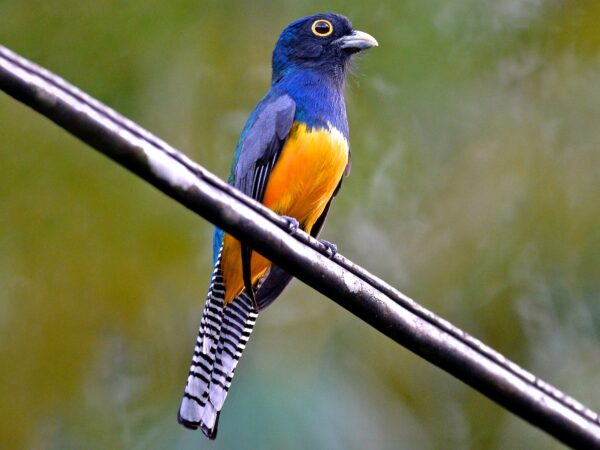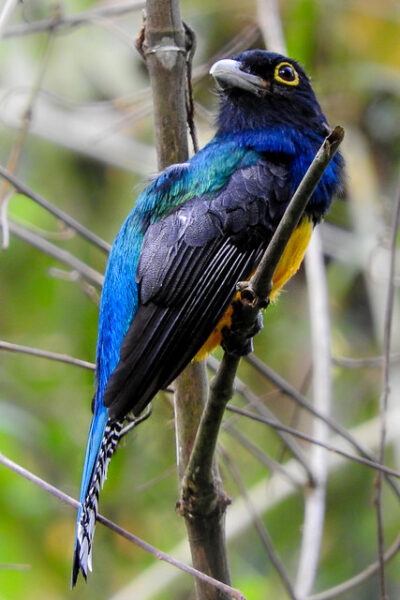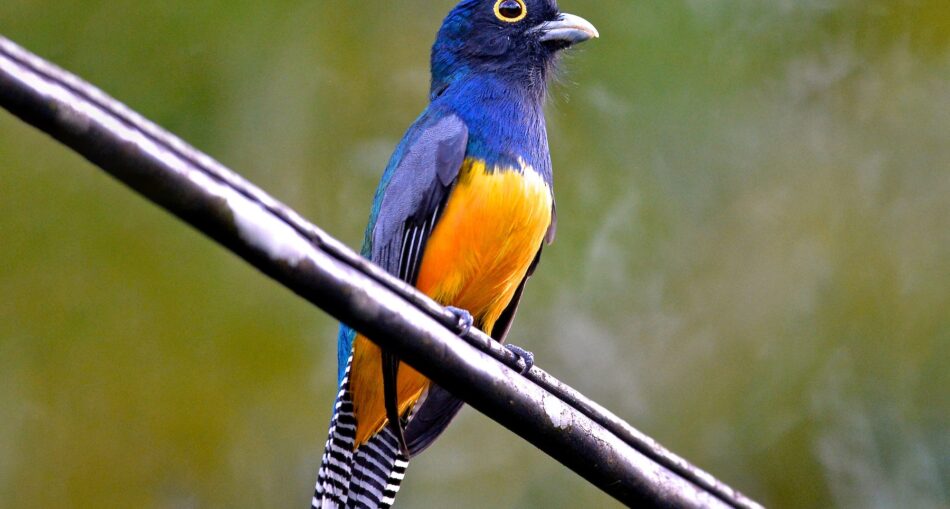Guyana’s rich biodiversity is a haven for bird lovers and nature enthusiasts alike. Among the many fascinating species that call this tropical paradise home is the vibrant Guianan trogon (Trogon violaceus).

Guianan Trogon [Photo: eBird]
THE GUIANAN TROGON: A LOOK AT ITS TAXONOMY AND SYSTEMATICS
The Guianan trogon was first formally described in 1788 by Johann Friedrich Gmelin, a renowned German naturalist, in his expanded edition of Carl Linnaeus’s Systema Naturae.
Gmelin based his description of the bird on earlier work by Joseph Gottlieb Kölreuter, a German botanist who first documented the species in 1765.
The Guianan trogon’s scientific name, Trogon violaceus, refers to the bird’s violet-coloured plumage.
In fact, the specific epithet violaceus comes from Latin, meaning ‘violet-coloured,’ which highlights one of the key features that make this bird so striking.
Historically, this species was grouped with the gartered trogon (Trogon caligatus) and the Amazonian trogon (Trogon ramonianus) under the name ‘violaceous trogon,’ but these are now considered separate species based on recent molecular phylogenetic studies.
Today, the Guianan trogon is recognised as a monotypic species, meaning it has no subspecies.
Despite this, it is often mistaken for other trogons due to its similar appearance, particularly to the green-backed and white-tailed trogons.
However, the Guianan trogon’s unique traits and habitat distinguish it from its relatives, and in the tropical forests of Guyana, it stands as an emblem of beauty and biodiversity.
PHYSICAL DESCRIPTION: A COLOURFUL SPECTACLE
One of the most captivating aspects of the Guianan trogon is its stunning plumage. The bird measures between 23 and 25 centimetres in length and weighs approximately 38 to 57 grams.
Like many trogon species, the Guianan trogon exhibits sexual dimorphism, meaning that males and females have distinctly different plumage.
MALE GUIANAN TROGON
The male Guianan trogon is a vivid combination of colours, with a violet-blue head, a black mask, and a pale blue-grey bill.
Its chest is also violet blue, sharply contrasting with its bright yellow belly. A narrow white band separates the chest from the underparts.
The bird’s upper body is metallic green, which adds to its iridescent appearance, especially in the sunlight.
The male’s tail is violet blue with black tips, while the lower surface of the tail is adorned with fine black-and-white barring and broad white tips.

Guianan Trogon [Photo: Kirsten Osa]
FEMALE GUIANAN TROGON:
In contrast, the female Guianan trogon has a more subdued colour palette. Her head and upperparts are dark grey, and her belly is a paler yellow than that of the male. Additionally, her wings are finely barred with black and white, giving her a more muted but equally beautiful appearance.
JUVENILES
Juvenile males resemble adult females in coloration but have browner wings and less white on the underside of their tails. Over time, they develop the vibrant plumage that distinguishes the adult males.
This remarkable coloration not only makes the Guianan trogon visually stunning but also influences its interactions within the forest environment.
DISTRIBUTION AND HABITAT IN GUYANA
The Guianan trogon thrives in Guyana’s tropical forests, especially in semi-open landscapes.
In Guyana, they are a common sight in the dense rainforests and savannas, favouring the edges of primary forests, young secondary forests, cacao and coffee plantations, and even areas of terra firme forest.
Their ability to adapt to a variety of semi-open habitats is what makes them so widespread in the region. They typically reside in lowland areas in Guyana.
FEEDING HABITS: A FRUIT AND INSECT DIET
The Guianan trogon’s diet mainly consists of fruit and arthropods, which they catch during short flights, known as sallies, from a perched position.
This bird is a master of patience. It sits still for extended periods before making abrupt, quick movements to catch its prey.
This behaviour is often observed when the trogon joins mixed-species foraging flocks, working together with other birds to maximise their feeding opportunities.
This combination of fruit and insect consumption places the Guianan trogon in a crucial ecological niche. It helps control insect populations while also aiding in seed dispersal through its fruit-based diet.
BREEDING AND NESTING: UNIQUE HABITAT CHOICES
The Guianan trogon’s breeding season typically occurs between November and June.
The bird is known for its unique nesting habits. It often chooses to excavate cavities in arboreal nests of paper wasps, ants, or termites.
It may also nest in rotting wood or within root masses of ferns, demonstrating its ability to use various nesting environments.
The bird typically lays two or three white eggs. Though details about incubation time are limited, the young fledge at least 17 days after hatching.
Nesting in ant or wasp nests may provide some protection against predators, as these insects are often aggressive defenders of their homes.
VOCALISATIONS: THE CALL OF THE FOREST
The Guianan trogon’s song is distinctive and adds to the acoustic tapestry of Guyana’s forests.
Its song consists of a rapid series of hollow, down-slurred whistles that sound like ‘kyu-kyu-kyu-kyu-kyu.’
Additionally, their calls include rolling and chattering notes. These vocalisations are often a key factor in identifying the bird, especially when visual sightings are challenging due to the dense forest cover.
Article References
- https://en.wikipedia.org/wiki/Guianan_trogon
- https://animalia.bio/guianan-trogon
- https://ebird.org/species/viotro2
Discover more from Things Guyana
Subscribe to get the latest posts sent to your email.







